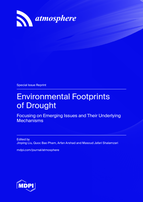Environmental Footprints of Drought: Focusing on Emerging Issues and Their Underlying Mechanisms
A special issue of Atmosphere (ISSN 2073-4433). This special issue belongs to the section "Meteorology".
Deadline for manuscript submissions: closed (7 April 2023) | Viewed by 25039
Special Issue Editors
2. Hydraulics and Geotechnics Section, KU Leuven, Kasteelpark Arenberg 40, BE-3001 Leuven, Belgium
Interests: extreme climatic events; climate change and human health impacts; hydrology modeling; water resources; vegetation remote sensing
Special Issues, Collections and Topics in MDPI journals
Interests: hydrology; groundwater; machine learning; water resources management; climate change; GIS; remote sensing
Special Issues, Collections and Topics in MDPI journals
Interests: geospatial modeling; urban cover changes; climate extremes; human impact assessment; environmental footprints
Special Issues, Collections and Topics in MDPI journals
Interests: heat waves; climate models; remote sensing; vegetation dynamics
Special Issues, Collections and Topics in MDPI journals
Special Issue Information
Dear Colleagues,
In recent decades, human activities, along with climatic variabilities, have adversely impacted socioeconomic and environmental conditions, leading to a growing drought susceptibility mainly in arid and semiarid parts of the world. Droughts are associated with the dynamic nature of human–environment interactions in ecosystems at different scales and dimensions, resulting in a wide range of issues such as soil and air quality deterioration, vegetation degradation, water scarcity, human migration, urban water supply issues, a reduction in hydropower production, etc., and so concerted efforts are required to bring all emergent concerns and their related processes together into a unified framework to serve as a roadmap for research and management. This Special Issue plans to attempt to offer a closer look into the dynamic nature of the natural and anthropogenic factors in generating compound droughts (hydro-meteorological, agricultural, and socioeconomic), with the ultimate goal of understanding the climate system's vulnerability, underlying effects of droughts, exposure, and sensitivity of the system, which could be used to kick-start the adaptation planning processes and reduce the drought risk in the 21st century. Scientists/researchers are encouraged to introduce ideas and concepts related to droughts, their classifications, assessment, relationships with large-scale climate patterns, and complex land–atmosphere feedback mechanisms by incorporating various data sources such as observations or modeling studies, targeted field campaigns, or long-term measurements ranging from local to regional spatial scales.
Dr. Jinping Liu
Dr. Quoc Bao Pham
Dr. Arfan Arshad
Dr. Masoud Jafari Shalamzari
Guest Editors
Manuscript Submission Information
Manuscripts should be submitted online at www.mdpi.com by registering and logging in to this website. Once you are registered, click here to go to the submission form. Manuscripts can be submitted until the deadline. All submissions that pass pre-check are peer-reviewed. Accepted papers will be published continuously in the journal (as soon as accepted) and will be listed together on the special issue website. Research articles, review articles as well as short communications are invited. For planned papers, a title and short abstract (about 100 words) can be sent to the Editorial Office for announcement on this website.
Submitted manuscripts should not have been published previously, nor be under consideration for publication elsewhere (except conference proceedings papers). All manuscripts are thoroughly refereed through a single-blind peer-review process. A guide for authors and other relevant information for submission of manuscripts is available on the Instructions for Authors page. Atmosphere is an international peer-reviewed open access monthly journal published by MDPI.
Please visit the Instructions for Authors page before submitting a manuscript. The Article Processing Charge (APC) for publication in this open access journal is 2400 CHF (Swiss Francs). Submitted papers should be well formatted and use good English. Authors may use MDPI's English editing service prior to publication or during author revisions.
Keywords
- roles of atmospheric circulation pattens in the development of droughts
- natural and anthropogenic influences
- climate extremes
- hydrological extremes
- land–atmosphere interactions (emergent risks associated with droughts)
- drought vulnerability, risk, and impact assessments
- sensitivity and adaptive capacity of environmental systems
- weather hazards and warning systems
- compound droughts
- drought increases CO2 footprints
- drought increases water scarcity
- effects on agricultural system
- downscaling of climate projections to inform droughts conditions over local scale
- numerical simulation models, resilience strategies, and decision-making tools








